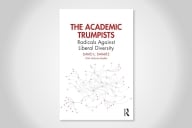You have /5 articles left.
Sign up for a free account or log in.
The first thing to know about Frederick Wiseman’s new film, “At Berkeley" – a sprawling, ambitious portrait of the institution in the fall of 2010 – is that it clocks in at a shade over four hours long. The film’s daunting length reflects the immensity and complexity of its subject: How can one begin to show a representative picture of a university encompassing over 36,000 students, over 2,000 full- and part-time faculty members, over 1,200 acres of land? And that's to say nothing of Berkeley's remarkable history and unique role in American academe.
But “At Berkeley” further attempts a delicate balancing act, gesturing repeatedly at the vastness of the university and the multiplicity of its operations while simultaneously homing in on a unified set of themes: What is the role of public higher education – and what does it mean to be both public and elite? And how can UC-Berkeley continue to embody those two defining (and sometimes competing) characteristics even as it receives less and less funding from a state decreasingly inclined or able to support higher education?
The scenes that Wiseman has compiled address those themes both literally and metaphorically, from perspectives both broad and narrow. The great majority of the film comprises people sitting in rooms, talking: administrators, most notably and ubiquitously then-Chancellor Robert Birgeneau, in various meetings on budgets, policies and strategies; and faculty and students in class discussions on topics ranging from literature to astrophysics to global poverty and inequality.
Splicing together these lengthy stretches of dialogue are short scenes offering a fuller view of campus life: music and theater performances, students conducting research, athletic matches, construction and maintenance, and everywhere people, walking dogs, exercising, bicycling between classes, or simply lying out in the sun.
While the movie’s scope is expansive, its themes begin to take shape in its latter two hours, as student protests over fees and cutbacks offer a focal point for the questions it raises about the present and future of public higher education. At the time the movie was filmed, UC's budget picture had improved slightly compared to the year prior, but students were just feeling the effects of a new 32 percent increase in fees. (Today, thanks in large part to a tax hike urged by Governor Jerry Brown and approved by voters, the situation is less dire.)
Wiseman does not use voiceovers, interviews, or title cards; his direction is understated, his own perspective suggested only by the scenes he has chosen and the ways in which they are juxtaposed. As a consequence, most of those who appear in the film – faculty, staff, administrators, students – are relatively anonymous, save when others address them by name. (The primary exception is Birgeneau, who is easily picked out by his bright white hair, distinctive Canadian accent, and near-constant presence.) The effect is at times disorienting – who are these people, one wonders as each new scene opens, and what is the context of this conversation? – but it serves to focus the viewer’s attention on the movie’s themes and the way they unite its disparate elements.
At a budget meeting early in the film, Birgeneau argues that a key part of maintaining the university’s “public character” in the face of declining state support is finding a way to increase financial aid for middle-class students, whose expected family contribution for financial aid purposes may be much higher than what their family can realistically afford. The university, he says, must “keep close track of what student debt is for the middle class.”
In a later scene, a middle-class student begins to cry as she describes her feeling of guilt over the cost of tuition – her family’s income has dropped due to the recession, she says, but is still too high to qualify her for any financial aid; she can only get unsubsidized loans.
Other thematic parallels crop up throughout the movie. In another meeting, Birgeneau states that the university has done well in recruiting and enrolling low-income students, but needs to “do some more work” on enrolling underrepresented minorities. (Already-low numbers of black students at Berkeley and similarly competitive UCLA dropped precipitously after California's 1996 ban on affirmative action in college admissions, Proposition 209; new strategies to improve those numbers have had minimal impact.) Elsewhere, black students discuss the various pressures that accompany being the only African American in a given class, and the feeling that white and Asian students exclude them from study groups. (A problem that persists today, according to a recent story in the Los Angeles Times.) And the lone black student in one classroom scene argues that white Americans only care about poverty and inequality when they are seen to impact white suburban communities.
Much of the film’s second half deals directly or thematically with student protests over rising fees and state disinvestment, among other issues. An elderly speaker at the Free Speech Movement Café gives a talk on social activism, telling a largely middle-aged audience that “the indispensable strength of America is a right of dissent.” A student ties together political, economic, and sociocultural reasons for the state’s higher education funding cuts. Birgeneau and other administrators meet to discuss security and related concerns prior to October 7, the planned day of protests.
But the film’s climax, insofar as there is one, is anticlimactic. When the day comes, students march chanting through campus and take over a library reading room, sending Birgeneau a list of their demands. But the protest is fragmented, disorganized, the demands many and divergent. A variety of speakers agree that the protesters must formulate a goal, but each offers a very different vision of what that goal might be.
“It’s actually helpful that the list [of demands] is so crazy,” we hear Birgeneau tell another administrator via speakerphone. “If they had a list of three things that we could conceivably be able to address, that would be much more effective.”
His administration responds with a deliberately vague statement in support of accessible public education, which the protesters boo – but the rally dies down quickly, with no evident impact. A shot of the same reading room later that evening shows it to be neat, empty, silent. A worker begins taking down the protest banner tacked above the library door.
In an administrative meeting afterward, Birgeneau dismisses the protest as “classic oppositional politics; there was no underlying philosophy.” And in a classroom discussion, students complain about having their classes and midterms disrupted on the day of the walk-out.
“Because we’re at Berkeley,” one student says, “we dance a fine line between encouraging free speech and protesting for what you believe in and also holding up the morals of higher education” – that is, she implies, not pulling the fire alarm when your fellow students are taking a test.
Administrators and students alike draw a contrast between the “single-issue” protests that took place at Berkeley and elsewhere in the 1960s, such as the Free Speech Movement, and the present-day protests that have “no clear-cut focus,” as another student says.
Wiseman has said that he is “concerned about avoiding didacticism,” and the film avoids offering any explicit commentary on the actions of students or administrators. But a few seemingly unrelated scenes woven among those of the protests offer possible lenses through which to view them.
In one, former U.S. Secretary of Labor Robert Reich, now a professor in Berkeley's Goldman School of Public Policy, delivers a lecture on the importance of ongoing self-evaluation. In order to become an effective leader, he says, you have to constantly be asking yourself, “…[W]hat am I trying to achieve? What’s my goal here? What are the criteria for achieving this, or knowing that we or I am getting to this goal?”
In another, George Breslauer, executive vice chancellor and provost, is briefly seen giving a talk on making compelling academic personnel cases. “You have to combine passion with discernment,” he says, attributing the phrase to a former vice provost.
“…The coin of the realm in academia is rational argumentation and marshaling of evidence,” Breslauer continues, “and that’s where the discernment part comes in. Passion is necessary for a variety of reasons – to maintain your morale, to maintain the perception of you as committed, and in order to energize you to pursue [your] ambitions – but discernment is equally important.” Successful advocacy, Breslauer says, requires the use of evidence and logic, not “mere cheerleading.”
While Reich and Breslauer are not speaking about student protests, the scenes stand in direct contrast to those of the October 7 rally, inviting the viewer to reflect on why the protesters’ efforts fail.
Life on campus continues. Birgeneau and other administrators discuss ramping up international recruitment – presumably to help improve the university’s finances. An English professor analyzes Donne’s “To His Mistress Going to Bed.” And an astronomy professor addresses a lecture hall on the possibility of humans one day traveling to other planetary systems – touching on a tacit theme of progress, forward movement, the advancement of knowledge, that may be almost inevitable in a documentary about a research university.
The film’s closing credits roll over a student theater performance set to Willie Nelson’s cover of “City of New Orleans.” The song feels metaphorically apropos, as a hymn to a vast country with many moving parts, but it’s an unexpectedly poignant end to a film that feels, on balance, hopeful. Wiseman’s Berkeley is a place where both administrators and students try to articulate broad ideals and apply them to their specific situations and environments. How should things be, the film’s subjects ask themselves and one another, and how are they now, and what might be done to begin to bridge the gap?
At Berkeley, Wiseman suggests, how things should be isn’t too far off from how they are.
"At Berkeley" is set for wide release Nov. 8; more information can be found on a UC-Berkeley website about the film.








